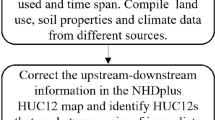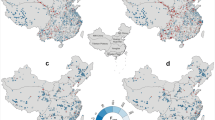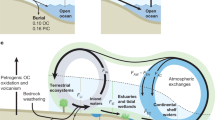Abstract
Drought impedes the lateral flux of carbon along continental river networks to the oceans due to reduction in water flow. Here we show that, in addition to lower flow, drought also exacerbates secondary carbonate formation and atmospheric CO2 emissions. We report sub-hourly field measurements of major ion chemistry in the upper Sangamon River in North America, revealing that drought accelerates the characteristically rapid pace of carbonate mineral formation at the watershed scale. Over 195 consecutive days of moderate hydrologic drought, we observe a 17% decrease in annual riverine lateral carbon flux due to secondary carbonate formation, in addition to the restrictions imposed by low flow rates, indicating a natural limit to the inorganic carbon carrying capacity of rivers. We use historical datasets and a compilation of global river geochemistry measurements to show that this phenomenon is reproducible and widespread during periods of drought.
This is a preview of subscription content, access via your institution
Access options
Access Nature and 54 other Nature Portfolio journals
Get Nature+, our best-value online-access subscription
$32.99 / 30 days
cancel any time
Subscribe to this journal
Receive 12 print issues and online access
$259.00 per year
only $21.58 per issue
Buy this article
- Purchase on SpringerLink
- Instant access to full article PDF
Prices may be subject to local taxes which are calculated during checkout



Similar content being viewed by others
Data availability
RiverLab data utilized in this study are available via a HydroShare data repository at https://doi.org/10.4211/hs.2c6c1d02c3ec4b97a767c787e1889647 (ref. 58). WQP water chemistry data are publicly available at https://www.waterqualitydata.us/. GLORICH data are publicly available at https://doi.org/10.1594/PANGAEA.902360 (ref. 50). GRDC data are publicly available at https://grdc.bafg.de/. The co-location data of GLORICH and GRDC stations are sourced from ref. 9.
References
Regnier, P. et al. Anthropogenic perturbation of the carbon fluxes from land to ocean. Nat. Geosci. 6, 597–607 (2013).
Raymond, P. A. & Hamilton, S. K. Anthropogenic influences on riverine fluxes of dissolved inorganic carbon to the oceans. Limnol. Oceanogr. Lett. 3, 143–155 (2018).
Tian, H. et al. Increased terrestrial carbon export and CO2 evasion from global inland waters since the preindustrial era. Glob. Biogeochem. Cycles 37, e2023GB007776 (2023).
Beerling, D. J. et al. Enhanced weathering in the US Corn Belt delivers carbon removal with agronomic benefits. Proc. Natl Acad. Sci. USA 121, e2319436121 (2024).
Kantola, I. B. et al. Improved net carbon budgets in the US Midwest through direct measured impacts of enhanced weathering. Glob. Change Biol. 29, 7012–7028 (2023).
Knapp, W. J. & Tipper, E. T. The efficacy of enhancing carbonate weathering for carbon dioxide sequestration. Front. Clim. 4, 928215 (2022).
Denissen, J. M. C. et al. Widespread shift from ecosystem energy to water limitation with climate change. Nat. Clim. Change 12, 677–684 (2022).
Xu, H. et al. Rising ecosystem water demand exacerbates the lengthening of tropical dry seasons. Nat. Commun. 13, 4093 (2022).
Graham, D. J., Bierkens, M. F. P. & van Vliet, M. T. H. Impacts of droughts and heatwaves on river water quality worldwide. J. Hydrol. 629, 130590 (2024).
van Vliet, M. T. H. et al. Global river water quality under climate change and hydroclimatic extremes. Nat. Rev. Earth Environ. 4, 687–702 (2023).
Li, L. et al. River water quality shaped by land–river connectivity in a changing climate. Nat. Clim. Change 14, 225–237 (2024).
Mosley, L. M. Drought impacts on the water quality of freshwater systems; review and integration. Earth Sci. Rev. 140, 203–214 (2015).
Breecker, D. O., Sharp, Z. D. & McFadden, L. D. Seasonal bias in the formation and stable isotopic composition of pedogenic carbonate in modern soils from central New Mexico, USA. Geol. Soc. Am. Bull. 121, 630–640 (2009).
Ortiz, A. C. et al. Dryland irrigation increases accumulation rates of pedogenic carbonate and releases soil abiotic CO2. Sci. Rep. 12, 464 (2022).
Saccardi, B. & Winnick, M. Improving predictions of stream CO2 concentrations and fluxes using a stream network model: a case study in the East River Watershed, CO, USA. Glob. Biogeochem. Cycles 35, e2021GB006972 (2021).
Lauerwald, R. et al. Inland water greenhouse gas budgets for RECCAP2: 1. state-of-the-art of global scale assessments. Glob. Biogeochem. Cycles 37, e2022GB007657 (2023).
Lauerwald, R. et al. Inland water greenhouse gas budgets for RECCAP2: 2. regionalization and homogenization of estimates. Glob. Biogeochem. Cycles 37, e2022GB007658 (2023).
Mendonça, R. et al. Organic carbon burial in global lakes and reservoirs. Nat. Commun. 8, 1694 (2017).
Dai, A. Increasing drought under global warming in observations and models. Nat. Clim. Change 3, 52–58 (2013).
Naumann, G. et al. Global changes in drought conditions under different levels of warming. Geophys. Res. Lett. 45, 3285–3296 (2018).
Friedlingstein, P. et al. Global carbon budget 2023. Earth Syst. Sci. Data 15, 5301–5369 (2023).
Regnier, P., Resplandy, L., Najjar, R. G. & Ciais, P. The land-to-ocean loops of the global carbon cycle. Nature 603, 401–410 (2022).
He, Q., Ju, W. & Li, X. Response of global terrestrial carbon fluxes to drought from 1981 to 2016. Atmosphere 14, 229 (2023).
Kumar, P. et al. Critical transition in critical zone of intensively managed landscapes. Anthropocene 22, 10–19 (2018).
Kumar, P. et al. Emergent role of critical interfaces in the dynamics of intensively managed landscapes. Earth Sci. Rev. 244, 104543 (2023).
Wilson, C. G. et al. The intensively managed landscape critical zone observatory: a scientific testbed for understanding critical zone processes in agroecosystems. Vadose Zone J. 17, 1–21 (2018).
Raymond, P. A., Oh, N.-H., Turner, R. E. & Broussard, W. Anthropogenically enhanced fluxes of water and carbon from the Mississippi River. Nature 451, 449–452 (2008).
Floury, P. et al. Linking dynamic water storage and subsurface geochemical structure using high-frequency concentration-discharge records. Water Resour. Res. 60, e2022WR033999 (2024).
Wang, J. et al. Sampling frequency, load estimation and the disproportionate effect of storms on solute mass flux in rivers. Sci. Total Environ. 906, 167379 (2024).
Lauerwald, R., Hartmann, J., Moosdorf, N., Kempe, S. & Raymond, P. A. What controls the spatial patterns of the riverinecarbonate system?—a case study for North America. Chem. Geol. 337–338, 114–127 (2013).
Low Water on the Mississippi Slows Critical Freight Flows (USDOT, 2022); https://www.bts.gov/data-spotlight/low-water-mississippi-slows-critical-freight-flows
Muñoz, S. E. et al. Mississippi River low-flows: context, causes, and future projections. Environ. Res.: Clim. 2, 031001 (2023).
Gaillardet, J., Dupré, B., Louvat, P. & Allègre, C. J. Global silicate weathering and CO2 consumption rates deduced from the chemistry of large rivers. Chem. Geol. 159, 3–30 (1999).
Dessert, C., Dupré, B., Gaillardet, J., François, L. M. & Allègre, C. J. Basalt weathering laws and the impact of basalt weathering on the global carbon cycle. Chem. Geol. 202, 257–273 (2003).
Munroe, J. S. Relation between regional drought and mountain dust deposition revealed by a 10-year record from an alpine critical zone. Science Total Environ. 844, 156999 (2022).
Raymond, P. A. et al. Scaling the gas transfer velocity and hydraulic geometry in streams and small rivers. Limnol. Oceanogr. 2, 41–53 (2012).
Raymond, P. A. et al. Global carbon dioxide emissions from inland waters. Nature 503, 355–359 (2013).
Appling, A. P., Hall, R. O. Jr, Yackulic, C. B. & Arroita, M. Overcoming equifinality: leveraging long time series for stream metabolism estimation. J. Geophys. Res. Biogeosci. 123, 624–645 (2018).
Zimmer, M. A. et al. Zero or not? Causes and consequences of zero-flow stream gage readings. WIREs Water 7, e1436 (2020).
Water Quality Portal (National Water Quality Monitoring Council, USGS & EPA); https://doi.org/10.5066/P9QRKUVJ
Konapala, G. & Mishra, A. Quantifying climate and catchment control on hydrological drought in the continental United States. Water Resour. Res. 56, e2018WR024620 (2020).
Meresa, H., Zhang, Y., Tian, J. & Abrar Faiz, M. Understanding the role of catchment and climate characteristics in the propagation of meteorological to hydrological drought. J. Hydrol. 617, 128967 (2023).
Van Loon, A. F. & Laaha, G. Hydrological drought severity explained by climate and catchment characteristics. J. Hydrol. 526, 3–14 (2015).
GRDC: The Global Runoff Data Centre (Global Runoff Data Centre (GRDC), 2020); https://portal.grdc.bafg.de/
Stark, J. R. Water Quality in the Upper Mississippi River Basin, Minnesota, Wisconsin, South Dakota, Iowa, and North Dakota, 1995–1998 (USGS Water Resources Division, 2000).
Voss, B. M., Wickland, K. P., Aiken, G. R. & Striegl, R. G. Biological and land use controls on the isotopic composition of aquatic carbon in the Upper Mississippi River Basin. Glob. Biogeochem. Cycles 31, 1271–1288 (2017).
Raymond, P. A. & Cole, J. J. Increase in the export of alkalinity from North America’s largest river. Science 301, 88–91 (2003).
Kozar, D., Dong, X. & Li, L. The recovery of river chemistry from acid rain in the Mississippi River basin amid intensifying anthropogenic activities and climate change. Sci. Total Environ. 897, 165311 (2023).
Fortner, S. K. et al. Silicate weathering and CO2 consumption within agricultural landscapes, the Ohio-Tennessee River Basin, USA. Biogeosciences 9, 941–955 (2012).
Hartmann, J., Lauerwald, R. & Moosdorf, N. A brief overview of the GLObal RIver Chemistry database GLORICH. Proc. Earth Planet. Sci. 10, 23–27 (2014).
Clark, I. & Fritz, P. Environmental Isotopes in Hydrology (Lewis Publishers, 1998).
Drever, J. I. The Geochemistry of Natural Waters: Surface and Groundwater Environments (Prentice Hall, 1997).
Plummer, L. N. & Busenberg, E. The solubilities of calcite, aragonite and vaterite in CO2-H2O solutions between 0 and 90 °C, and an evaluation of the aqueous model for the system CaCO3-CO2-H2O. Geochim. Cosmochim. Acta 46, 1011–1040 (1982).
Dreybrodt, W. Processes in Karst Systems Vol. 4 (Springer, 1988).
Krumgalz, B. S. Temperature dependence of mineral solubility in water. part 3. alkaline and alkaline Earth sulfates. J. Phys. Chem. Ref. Data 47, 023101 (2018).
Hall, F. R. Dissolved solids-discharge relationships: 1. mixing models. Water Resour. Res. 6, 845–850 (1970).
Wymore, A. S. et al. Revisiting the origins of the power-law analysis for the assessment of concentration-discharge relationships. Water Resour. Res. 59, e2023WR034910 (2023).
Wang, J. et al. High-frequency major ion concentration of the Sangamon River from RiverLab (Aug 2021–Jun 2023). HydroShare https://doi.org/10.4211/hs.2c6c1d02c3ec4b97a767c787e1889647 (2025).
Yang, J., Liu, H., Tang, Z., Peeters, L. & Ye, M. Visualization of aqueous geochemical data using Python and WQChartPy. Groundwater 60, 555–564 (2022).
Acknowledgements
This study is supported by the NSF EAR-2012850, Network Cluster CINet: Critical Interface Network in Intensively Managed Landscapes. M.J.W. was supported by NSF EAR-2318056. We acknowledge the United States Geological Survey, GLObal RIver CHemistry Database, Global Runoff Data Centre and Water Quality Portal. We thank E. Bauer, A. J. Stumpf, J. Haken, A. Dolant, P. Floury and S. Baron for RiverLab construction and maintenance. We thank D. J. Graham for providing the co-location data of GLORICH and GRDC stations.
Author information
Authors and Affiliations
Contributions
J.W. was responsible for data collection, curation and analysis, paper writing and figures. J.B. contributed to the study design, analysis and paper writing. M.J.W., A.E.G. and A.D. contributed analysis and aided in paper writing. P.K. was responsible for funding acquisition and contributed to paper writing. J.L.D. led and designed the study, guided analysis and contributed to paper writing.
Corresponding authors
Ethics declarations
Competing interests
The authors declare no competing interests.
Peer review
Peer review information
Nature Geoscience thanks John Higgins, Robert Hilton and Pierre Regnier for their contribution to the peer review of this work. Primary Handling Editors: Carolina Ortiz Guerrero and Tom Richardson, in collaboration with the Nature Geoscience team.
Additional information
Publisher’s note Springer Nature remains neutral with regard to jurisdictional claims in published maps and institutional affiliations.
Extended data
Extended Data Fig. 1 Time series of river discharge and solute concentrations at the RiverLab located in Monticello, IL.
a, Major cation concentrations (K+, Na+, Mg2+, Ca2+; in mM). Concentrations of K+ are presented at 10x for better visualization. b, Major anion concentrations (Cl−, NO3−, SO42−; in mM). River discharge (in m3/s) is shown by the gray filled curve and the 2022 drought period is unshaded. c, Inferred calcium (Ca2+; in mM) based on the long-term Ca:Na molar ratio of the river.
Extended Data Fig. 2 Piper diagram of the Upper Sangamon River hydrochemistry during the 2022 drought and non-drought periods based on RiverLab data.
The diagram is generated using WQChartPy59 python package and the average concentration of each solute is displayed. A significant transition of river water composition can be observed between drought and non-drought conditions. During drought, the proportion of Na+, K+, and Cl− increased while the level of Ca2+ and HCO3− decreased.
Extended Data Fig. 3 Time series of anion concentrations normalized to their flux-weighted mean values outside of the drought period.
River discharge (in m3/s) is shown by the gray filled curve.
Extended Data Fig. 4 Drought-induced perturbation of the terrestrial inorganic carbon cycle.
Prolonged periods of drought promote secondary carbonate formation within the landscape, leading to increased CO2 evasion compared to long term, ambient conditions. Combined with lower water flow, this process impedes lateral carbon flux by rivers. These shifts in carbon fluxes are signaled by an attendant stability in calcium concentrations while sodium and other major ions increase due to evapo-concentration. These increased concentrations counterbalance reduced flow rates to maintain a high mass flux. High-frequency hydrochemical recording by the RiverLab installation in the agricultural Upper Sangamon River catchment provides evidence of these shifts, manifesting as a systematic decrease in the Ca/Na molar ratio of the river.
Extended Data Fig. 5 Time series of conductivity and ionic strength in the Upper Sangamon River measured in the RiverLab.
a, Conductivity (in μS/cm). b, Ionic strength (in mM). River discharge (in m3/s) is shown by the gray curve with filling and 2022 drought period is highlighted by white background.
Extended Data Fig. 6 Excess terrestrial carbon emissions during periods of drought across Europe.
Values (in kg C/km2-day) are based on 308 individual GLORICH50 stations, each of which offers at least 3 measurements of Na and Ca during a period of Q10 drought based on the Global Runoff Data Centre (GRDC)44. Watersheds which naturally exhibit solute compositions near or above saturation with respect to calcite are outlined in red. Those that naturally fall below this point are outlined in blue. Basemap from Natural Earth (https://www.naturalearthdata.com).
Extended Data Fig. 7 Multiple estimations of excess terrestrial carbon emissions during periods of drought across continental United States.
a-c, Q10, Q20 and Q30 with at least 1 measurement of Na+ and Ca2+ under drought. d-f, Q10, Q20 and Q30 with at least 2 measurements. g-i, Q10, Q20 and Q30 with at least 3 measurements. Watersheds that are near or above saturation with respect to calcite are outlined in red. Undersaturated watersheds are outlined in blue. Basemaps from Natural Earth (https://www.naturalearthdata.com).
Supplementary information
Supplementary Information
Supplementary Figs. 1–8, discussion and Tables 1–4.
Rights and permissions
Springer Nature or its licensor (e.g. a society or other partner) holds exclusive rights to this article under a publishing agreement with the author(s) or other rightsholder(s); author self-archiving of the accepted manuscript version of this article is solely governed by the terms of such publishing agreement and applicable law.
About this article
Cite this article
Wang, J., Bouchez, J., Winnick, M.J. et al. Drought constrictions on lateral carbon transport. Nat. Geosci. (2025). https://doi.org/10.1038/s41561-025-01807-z
Received:
Accepted:
Published:
DOI: https://doi.org/10.1038/s41561-025-01807-z



